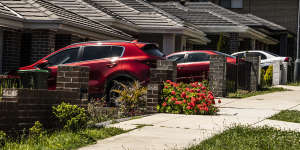Australian Bureau of Statistics data confirmed the nation’s two largest property markets have borne the brunt of the drop in property values,with the average price of residential dwellings in NSW losing more than $500 a day through the three months to the end of June.

The value of all dwellings slipped by $162 billion in the June quarter.Louise Kennerley
Property prices soared through the COVID-19 pandemic,aided by record low interest rates and government support programs.
Between the March quarter of 2020 and this year’s March quarter,the value of all Australian dwellings swelled from $7.3 trillion to $10.1 trillion – the largest increase in value on record.
But the lift in inflation,which forced the Reserve Bank to raise interest rates by 0.75 percentage points in the June quarter,has had an immediate impact on the property market.
The value of all dwellings slipped by $162 billion in the June quarter. Values fell by $142 billion in NSW and $62.6 billion in Victoria. There were also much smaller drops in Tasmania and the ACT.
The mean price of a residential dwelling is now under $1.2 million in NSW,at $991,500 in the ACT and $938,900 in Victoria.

The slip in property values is playing into key measures of consumer confidence,with both the ANZ-Roy Morgan weekly and the Westpac monthly indicators,released on Tuesday,still showing sentiment at deep recessionary levels.
But National Australia Bank’s measure of business sentiment showed a further lift in confidence and trading conditions through August. Employment and profitability measures of businesses remain strong,as do cost pressures.
The combination of higher retail costs and official interest rates,however,may be starting to bite consumers.
Data compiled by Commonwealth Bank,released on Tuesday,showed a drop through August in expenditure plans in the discretionary part of the economy including travel,entertainment and retail.
The bank’s household spending intentions index,which is compiled from the CBA’s own payments data,loan application information and Google Trends,increased by 0.8 per cent in August.
But CBA chief economist Stephen Halmarick said the small lift highlighted the overall momentum in the economy plus the impact of inflationary pressures.
He said there were clear signs that consumers were starting to change their spending plans.
“While the index rose in August,we’re seeing weakness in discretionary spending following recent interest rate increases and a growing move to value purchasing. For instance,while grocery spending remains high,we’re hearing customers are swapping to value products in response to higher food prices,” he said.
The Reserve Bank governor has warned more interest rate rise hikes are on the way.
“Spending for household services has also risen 4 per cent in August,with charitable donations leading the category,likely signalling a stressful environment for many in the community.”
Through August,there was a 13.3 per cent lift in spending intentions on motor vehicles,which the bank said suggested there had been an easing in international supply chain constraints. Data from the Federal Chamber of Automotive Industries last week showed a lift through August.
There was also a 7.2 per cent increase in health and fitness,mostly due to higher planned expenditure on medical services,doctors and hospitals.
But spending intentions dropped by 3.9 per cent for travel and 7.2 per cent for entertainment,which the bank said might be partly attributable to the end of the run of theTop Gun sequel in cinemas.
CBA said there had been a rise in home loan applications in August,picking up refinancing activity,but they were well below levels a year ago.
Retail spending intentions dropped by 1.3 per cent,largely due to a slip in expenditure on discretionary items,including men’s and women’s clothing,shoes,sports and riding apparel and through home supply stores.
There had been a lift in plans to spend on groceries,electronics,nurseries and garden supplies.
The report covers August,during which the RBA lifted rates by half a percentage point. It followed that last week with another 0.5 percentage point increase,taking the official cash rate to a seven-year high of 2.35 per cent.
Cut through the noise of federal politics with news,views and expert analysis from Jacqueline Maley..